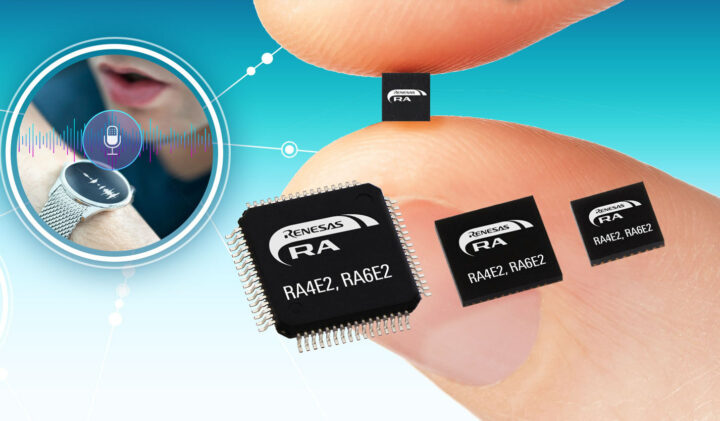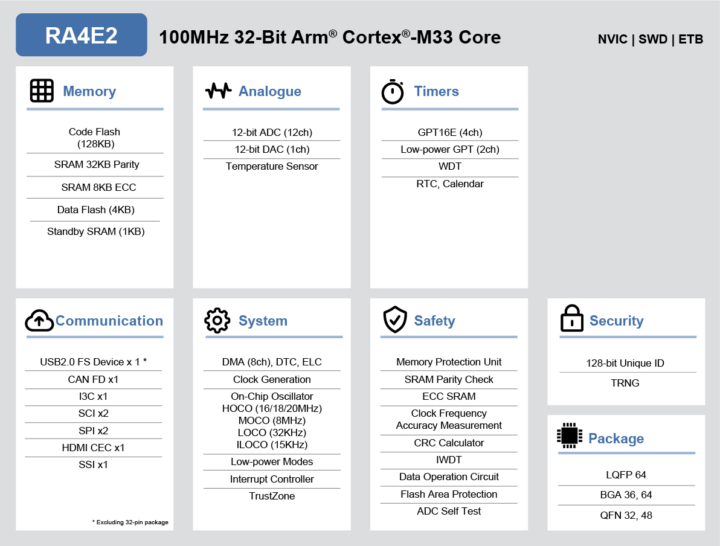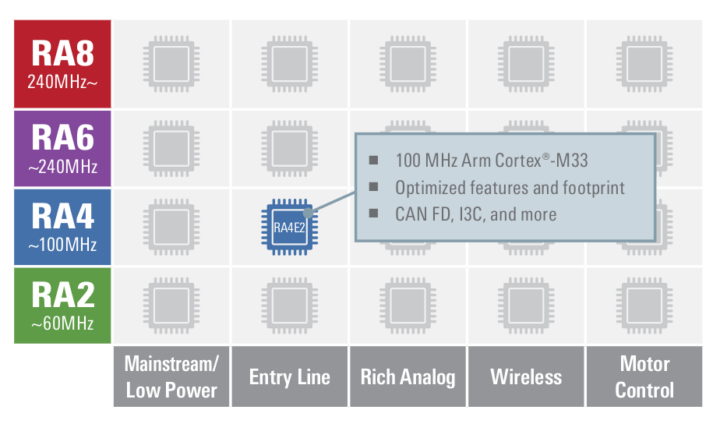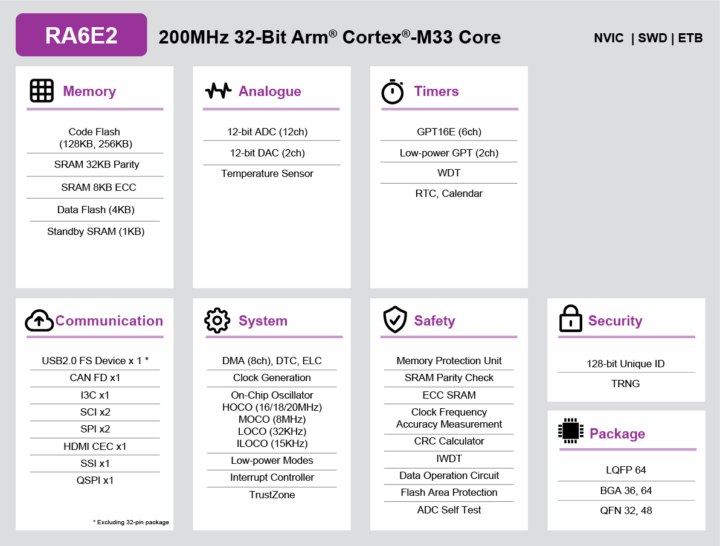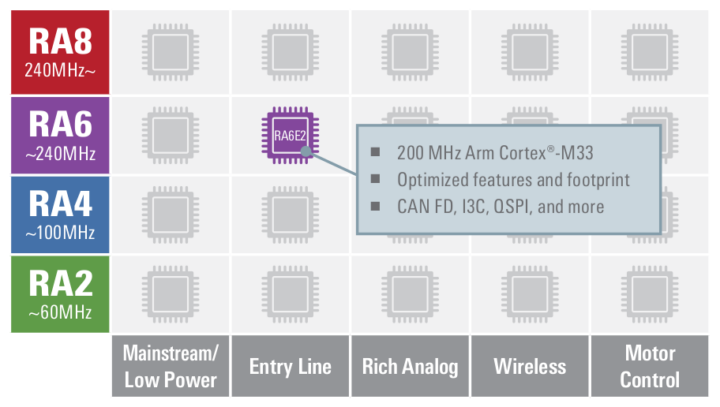Renesas Electronics has added two new groups to its 32-bit RA family of microcontrollers (MCUs) with the 100 MHz RA4E2 and 200 MHz RA6E2 Arm Cortex-M33 microcontrollers designed for “high-performance applications” in small packages such as sensing, gaming, wearables, and appliances.
The new microcontrollers are equipped with 40 KB SRAM, 128 KB or 256 KB flash, and integrate various on-chip interfaces such as CAN FD, USB, QSPI, SSI, and I3C interfaces to offer an easy upgrade path for products based on other members of the Renesas RA Family.
Renesas RA4E2 MCU group
Both the RA4E2 and the RA6E2 are the most cost-effective microcontroller groups of the RA family with integrated CAN FD, with the RA4E2 group especially well-suited to cost-sensitive applications and other systems requiring relatively high performance, low power consumption, and/or small package size.
RA4E2 key features:
- CPU – Arm Cortex-M33 core with TrustZone @ up to 100 MHz
- Memory – 40 kB SRAM, 1kB standby SRAM
- Storage – 128kB flash, 4kB data flash to store data as in EEPROM
- Peripherals – GPIO, 12-bit ADC, 12-bit DAC, USB 2.0 full-Speed Device, SCI, SPI, I3C, HDMI CEC, SSI, PWM, and CAN FD
- Misc – Internal oscillator, low-voltage detection, internal reset function
- Power consumption – 82 µA / MHz in active mode while executing at 100 MHz
- Packages – 32- to 64-pin packages: LQFP64, BGA36, BGA64, QFN32, QFN48
- Temperature Range – -40 to 105°C
Five RA4E2 devices are available now with different packages from 32-pin to 64-pin. The RA4E2 is positioned as an entry-level MCU group clocked at 100 Mhz like the other RA4 microcontrollers.
Development can be performed in Renesas e2studio IDE, Keil MDK, or IAR EWARM, and the microcontroller group is supported by FreeRTOS and Azure RTOS. Renesas also provides the RTK7EKA4E2S00001BE development kit for evaluation and early software/firmware development.
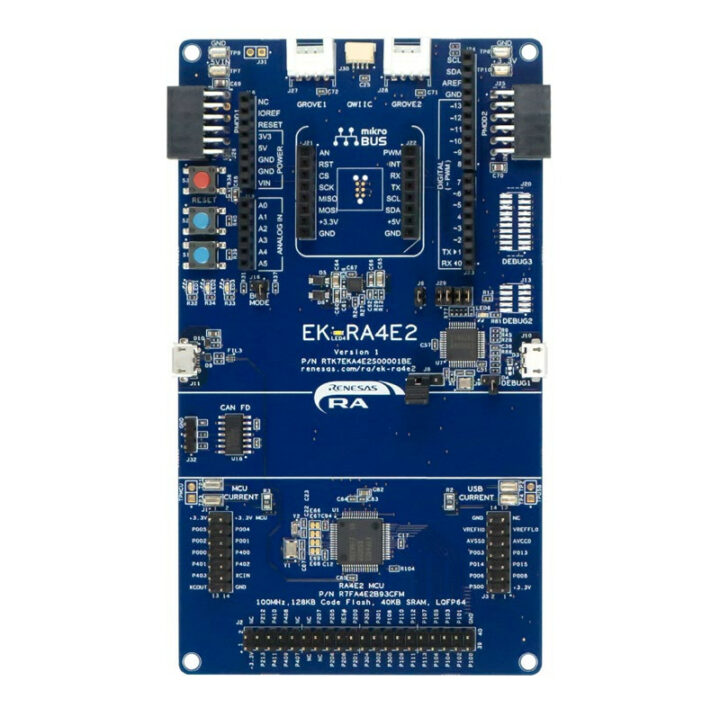
You’ll find more information, documentation, design package, development tools, and software on the devkit product page.
Renesas RA6E2 MCU Group
The RA6E2 group is almost identical to the RA4E2 group, except for the higher 200 MHz core frequency, the ability to select 128KK or 256KB flash, and one QSPI interface that is missing from the lower-end MCU group.
Key Features of the RA6E2 group:
- CPU – Arm Cortex-M33 core with TrustZone @ up to 200 MHz
- Memory – 40 kB SRAM, 1kB standby SRAM
- Storage – 128kB or 256KB flash, 4kB data flash to store data as in EEPROM
- Peripherals – GPIO, 12-bit ADC, 12-bit DAC, USB 2.0 full-Speed Device, SCI, SPI, I3C, HDMI CEC, SSI, PWM, QSPI, and CAN FD
- Misc – Internal oscillator, low-voltage detection, internal reset function
- Power consumption – 80 µA / MHz in active mode while executing at 200 MHz
- Packages – 32- to 64-pin packages: LQFP64, BGA36, BGA64, QFN32, QFN48
- Temperature Range – -40 to 105°C

The RA6E2 doubles the number of devices to 10 compared to the RA4E2 simply because of versions with 128KB or 256KB flash. The RA6E2 is also positioned as an entry-level MCU group but clocked at a higher 200 MHz frequency.
Software development options are the same as for the RA4E2 family, and Renesas also offers a similar RTK7EKA6E2S00001BE development kit with PMOD, Grove, Qwiic, and mikroBUS connectors for expansion, as well as on-board debugging using SEGGER J-Link.
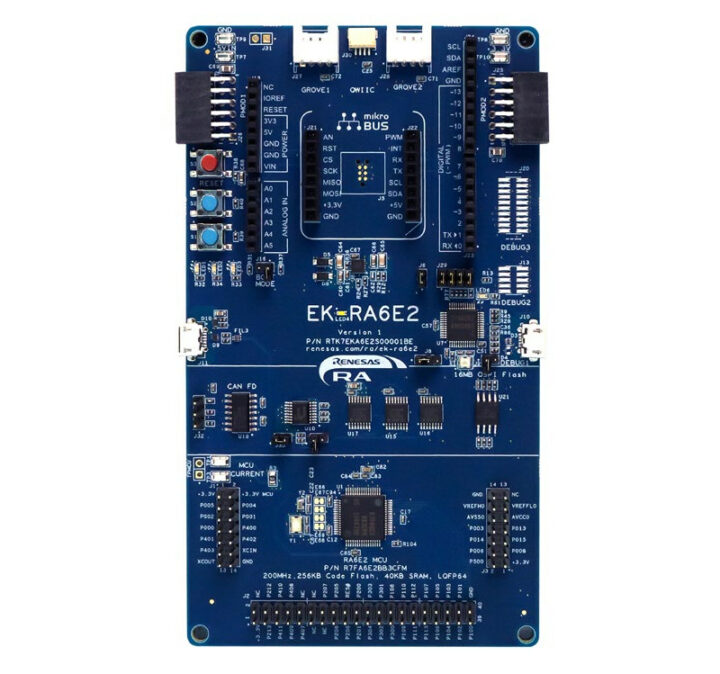
Renesas has designed one of their so-called “Winning Combination” with the “Add-on Voice User Interface (VUI)” solution/reference design based on the RA6E2 MCU designed to add a Voice User Interface to devices such as thermostats or appliances. In this design, the RA6E2 MCU handles all tasks related to the voice interface without relying on the host MCU.
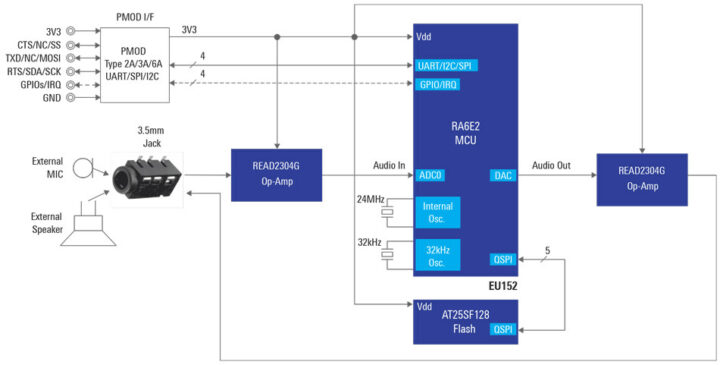
Availability
Renesas says the RA4E2 and RA6E2 Cortex-M33 MCUs are available today, and so are the development kits with the RTK7EKA4E2S00001BE devkit in stock at Digi-Key for $82.50. Additional information can be found on the product pages for the RA4E2 and RA6E2 MCU groups, as well as in the press release for Embedded World 2023.

Jean-Luc started CNX Software in 2010 as a part-time endeavor, before quitting his job as a software engineering manager, and starting to write daily news, and reviews full time later in 2011.
Support CNX Software! Donate via cryptocurrencies, become a Patron on Patreon, or purchase goods on Amazon or Aliexpress


